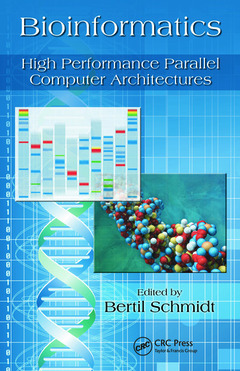Bioinformatics High Performance Parallel Computer Architectures Embedded Multi-Core Systems Series

New sequencing technologies have broken many experimental barriers to genome scale sequencing, leading to the extraction of huge quantities of sequence data. This expansion of biological databases established the need for new ways to harness and apply the astounding amount of available genomic information and convert it into substantive biological understanding.
A complilation of recent approaches from prominent researchers, Bioinformatics: High Performance Parallel Computer Architectures discusses how to take advantage of bioinformatics applications and algorithms on a variety of modern parallel architectures. Two factors continue to drive the increasing use of modern parallel computer architectures to address problems in computational biology and bioinformatics: high-throughput techniques for DNA sequencing and gene expression analysis?which have led to an exponential growth in the amount of digital biological data?and the multi- and many-core revolution within computer architecture.
Presenting key information about how to make optimal use of parallel architectures, this book:
- Describes algorithms and tools including pairwise sequence alignment, multiple sequence alignment, BLAST, motif finding, pattern matching, sequence assembly, hidden Markov models, proteomics, and evolutionary tree reconstruction
- Addresses GPGPU technology and the associated massively threaded CUDA programming model
- Reviews FPGA architecture and programming
- Presents several parallel algorithms for computing alignments on the Cell/BE architecture, including linear-space pairwise alignment, syntenic alignment, and spliced alignment
- Assesses underlying concepts and advances in orchestrating the phylogenetic likelihood function on parallel computer architectures (ranging from FPGAs upto the IBM BlueGene/L supercomputer)
- Covers several effective techniques to fully exploit the computing capability of many-core CUDA-enabled GPUs to accelerate protein sequence database searching, multiple sequence alignment, and motif finding
- Explains a parallel CUDA-based method for correcting sequencing base-pair errors in HTSR data
Because the amount of publicly available sequence data is growing faster than single processor core performance speed, modern bioinformatics tools need to take advantage of parallel computer architectures. Now that the era of the many-core processor has begun, it is expected that future mainstream processors will be parallel systems. Beneficial to anyone actively involved in research and applications, this book helps you to get the most out of these tools and create optimal HPC solutions for bioinformatics.
Algorithms for Bioinformatics.Introduction to GPGPUs and Massively Threaded Programming. FPGA: Architecture and Programming. Parallel Algorithms for Alignments on the Cell BE. Orchestrating the Phylogenetic Likelihood Function on Emerging Parallel Architectures. Parallel Bioinformatics Algorithms for CUDA-enabled GPUs. CUDA Error Correction Method for High-Throughput Short-Read Sequencing Data. FPGA Acceleration of Seeded Similarity Searching. Seed-Based Parallel Protein Sequence Comparison Combining Multithreading, GPU, and FPGA Technologies. Database Searching with Profi le Hidden Markov Models on Reconfi gurable and Many-Core Architectures. COPACOBANA: A Massively Parallel FPGA-Based Computer Architecture. Accelerating String Set Matching for Bioinformatics Using FPGA Hardware. Reconfigurable Neural System and its Application to Dimeric Protein Binding Site Identification. Parallel FPGA Search Engine for Protein Identification. Index.
Bertil Schmidt is Associate Professor at the School of Computer Engineering at Nanyang Technological University (NTU), Singapore. Prior to that, he was faculty member at the University of New South Wales and Senior Researcher at the University of Melbourne, Australia. At NTU he also held appointments as Program Director M.Sc. in Bioinformatics and Deputy Director of BMERC. Before coming to Singapore, he held research appointments at the Karlsruhe Institute of Technology (KIT) and RWTH Aachen. Bertil has been involved in the design and implementation of parallel algorithms and architectures for over a decade. He has worked extensively with fine-grained (e.g. GPUs, FPGAs, Cell BE), coarse-grained (clusters, grids) as well as hybrid parallel architectures. He has successfully applied these technologies to various domains including bioinformatics, image processing, multimedia video compression, and cryptography. He has published more than 35 journal papers in leading journals such as Journal of VLSI Signal Processing, Microelectronic Engineering, IEEE Transactions on Circuits and Systems II, IEEE Transactions on Parallel and Distributed Systems, IEEE Transactions on IT in Biomedicine, Journal of Parallel and Distributed Computing, Parallel Computing, Concurrency and Computation: Practice and Experience, Future Generation Computer Systems, Bioinformatics, BMC Bioinformatics, Autoimmunity, and Computer Physics Communications.
Date de parution : 07-2010
Ouvrage de 400 p.
15.6x23.4 cm
Thèmes de Bioinformatics :
Mots-clés :
FPGA; Bloom Fi Lter; Algorithms for Bioinfonnatics; Execution Time; Emerging Parallel Architectures and Programming Models; Query Sequence; Parallel Biological Sequence Alignments on Cell RE; MSA; Optimizing Smith-Watennan for Cell RE and Multi-cores; Thread Block; Orchestrating the Phylogenetic Likelihood Function on Emerging Parallel Architectures; Block RAM; Parallel Multiple Sequence Alignment on GPUs; Global Alignment; CUDA-enabled BLASTP; Optimal Alignment; Parallel Tools for Second-Generation Sequencing Technologies on GPUs; Ungapped Alignment; Accelerating Molecular Dynamics with CUDA; Global Memory; Bioseqeunce Similarity Search on FPGAs; FPGA Implementation; Parallel Genomic Sequence Comparison using Many-core; GPU and FPGA Technologies; SPEs; Accelerating HMMer on FPGAs; Smith Waterman Algorithm; Motif Finding on COPACOBANA; Local Alignment; String Set Matching on FPGAs; DMA Transfer; Hopfield Neural Network for DNA Motif Finding on FPGAs; Challenge Response Pairs; Processing Mass Spectrometric Data for Proteomics on FPGAs; Dynamic Programming Tables; Peptide Sets; FPGA Platform; GPU Kernel; Virtual Root; Pairwise Alignment; Branch Length; Probability Vectors


